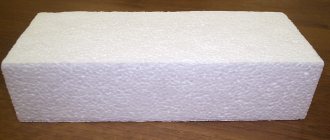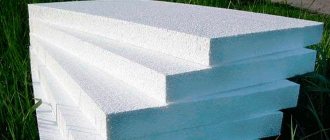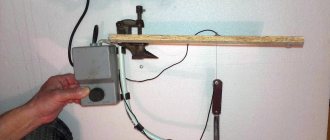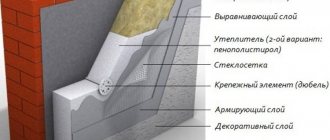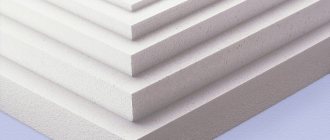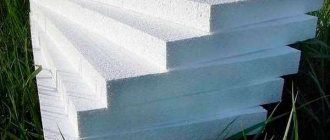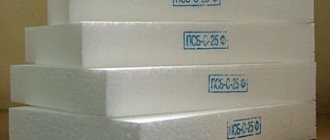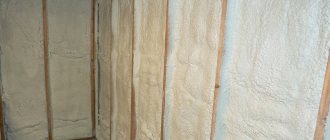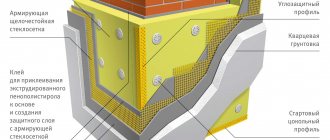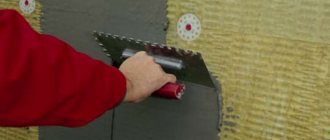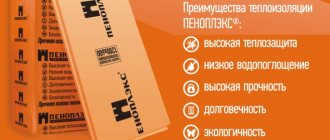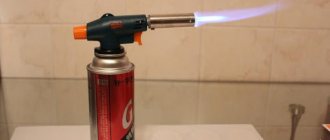Features of the material
Polystyrene foam is white sheets with low weight. If we talk about pressless PSB-S, it looks like small balls connected to each other. It contains up to 98% air. Despite this, the technical characteristics of the PSB-S 35 remain at their best.
The abbreviation is deciphered as follows. The letters "PS" stand for "polystyrene". The letter “B” is “pressless”, “C” is “self-extinguishing”. The numbers indicate maximum density. In this case, the specific gravity of the material is in the range of 25-35 kg/m3.
PSB-S 35 is capable of withstanding high loads. In this case, the slab does not sag or move. Polystyrene foam does not absorb water. Due to this, it does not change its size and shape. The mechanical, thermal insulation and technical characteristics of PSB-S 35 do not change throughout the entire service life.
Construction polystyrene foam PSB-S
What it is?
Expanded polystyrene PSB-S 25 in original packaging.
Before us is PSB-S, which means “suspension pressless self-extinguishing polystyrene foam.” Foamed plastics are used very widely in various fields of human activity. In construction, polystyrene foam or simply polystyrene foam is most often used, since this material most fully corresponds to the tasks assigned to it.
Expanded polystyrene is most often used in construction.
Due to the foamed cellular structure, polystyrene foam has very low thermal conductivity, so its main function is thermal insulation of various structures. Depending on the brand and qualities of a particular material, the scope of its application also changes.
Insulation of walls and other parts of buildings is the main function of PSB-S.
Expanded polystyrene was invented a long time ago, and during this time a lot of methods for its production and, accordingly, varieties were invented.
The most famous are:
- Pressless suspension. This is PSB, EPS. Known for the brands “MOSSTROY 31”, “NovoPlast”, “ET-Plast”.
- Extrusion. This is EPS, XPS. Known for the brands Penoplex, TechnoNIKOL, URSA, Knauf.
- Press. This is PS1 - PS4. Known for a variety of imported brands. Used extremely rarely.
- Autoclave. This is Styrofoam. Known as a product of the Dow Chemical Company.
- Autoclave extrusion. There are no examples of this material on the domestic market.
Extruded polystyrene foam "Penoplex".
Certificate of conformity GOST 15588-86 PSB-S slabs.
The letter “C” at the end of the PSB abbreviation tells us that fire-fighting substances (or fire retardants) were added to the polystyrene suspension during the production of the material, and now the material is called “self-extinguishing.”
The number 35 indicates the density of the insulation, which at its maximum value can be no more than 35 kg/m³.
The name of the material may also contain the following letters:
- “F” means “shaped”, that is, the sheet has a special shape;
- “N” – for outdoor use, façade;
- “A” – the sample has smooth edges like a geometrically regular parallelepiped;
- “B” – the edges of the slab are cut in an L-shape;
- “R” – the sheet is cut with a hot string.
The sheets are installed on the usual “umbrellas”.
The photo shows that self-extinguishing foam does not support combustion.
PSB is the same polystyrene foam.
Technical features and characteristics
“Little brother” of the hero of our article.
The technical characteristics of grade 35 are not very different from the general characteristics of suspension foam, but they have some features. Thanks to these nuances, it is easier for the buyer to select a material that will most accurately suit the operating conditions and perform the tasks assigned to it.
Differences between the 35th brand and others.
For wall insulation, foam plastic with a density of 25 kg/m³ is recommended, that is, grade 25 or 35.
Main indicators characterizing polystyrene foam PSB-35-S:
- Thermal conductivity at 20 – 30 °C, W/m*°C – 0.037 – 0.038.
- Density, kg/m³ – 25.1 – 35.
- Compressive strength at 10% deformation, MPa – 0.16.
- Ultimate strength under bending force – 0.25 MPa.
- Vapor permeability, mg/h*m*Pa – 0.05.
- Service life without loss of basic operational and technical characteristics is 60 – 80 years.
- Flammability class according to GOST standards - G1 (low-flammable).
- Water absorption during the day (24 hours),% – no more than 2 by volume.
- There are no toxic emissions harmful to humans under normal operating conditions, even taking into account the low-temperature destruction of EPS.
High-density foam is used as permanent formwork.
From the list it is clear that this brand of foam is characterized by relatively high compressive strength and density.
This is one of the highest quality brands in the range of PSB-S materials, which can be used as:
- floor insulation;
- road surfaces;
- underground communications and foundations;
- in the manufacture of reinforced concrete multilayer panels.
Insulation of the floor using 35-gauge polystyrene foam.
Thermal insulation of the foundation PSB-S.
Insulation of the well with polystyrene foam.
Thermal insulation of the septic tank with polystyrene foam.
Advantages and disadvantages
Among the positive qualities of the material are:
- Vapor tightness.
- Does not absorb water.
- Environmentally friendly.
- Prevents the development of mold and fungi.
- Doesn't rot.
- Does not react with acids, weak alkalis, alcohol and salts.
- Does not react with components of concrete mixtures and other similar building materials.
- Resistant to fire, as it is treated with a fire retardant.
- It is light in weight.
- It is convenient to work during installation (it is easy to cut without emission of dust).
- Long service life (over 35 years).
The PSB-S 35 stove also has its disadvantages. There are few of them compared to the advantages. The main disadvantage of the material is its ability to release toxic substances during combustion, which are very dangerous to human health. In addition, polystyrene foam is destroyed by exposure to solvents and bitumen-based materials. Expanded polystyrene is a good habitat for rodents (mice, rats, etc.).
Technical characteristics of PSB-S 35
Expanded polystyrene is produced in the form of rectangular sheets of standard sizes. So, the length varies from 900 to 5000 mm. Moreover, the value increases at intervals of 50 mm. The width is 500-1300 mm (step - 50 mm). The thickness of the material changes in steps of 10 mm and is in the range of 20-500 mm.
Other technical data include:
- Density is in the range of 25.1-35.0 kg/m3.
- The material burns for less than 4 seconds.
- Humidity - up to 12%.
- During the day, the material absorbs no more than 2% of the volume.
- The limiting value of bending strength is 0.25 MPa.
- Ultimate compressive strength - 0.14 MPa.
One of the main parameters that provides a wide range of applications is the ability of foam to retain heat. The thermal conductivity of PSB-S 35 is at a very low level and amounts to no more than 0.038 W/(m*K), which is typical for the dry state.
Technical characteristics of polystyrene foam board
PSB S 35 has the following performance characteristics.
| Index | Meaning |
| Density | 25-35 kg/m3 |
| Resistance to linear compression | 0.14 MPa |
| Flexural strength | 0.2 MPa |
| Thermal conductivity | 0.038 W (mK) |
| Water absorption per day | 2% of total volume |
| Burning time | no more than 4 s when exposed to open fire |
Interesting technical characteristics include the hypoallergenic nature of the material. Thanks to this feature, PSB S 35 can be used to insulate children's rooms; during work, there is no need to use personal protective equipment. Compared to the related penoplex, this is an undeniable plus.
Application area
Due to its technical characteristics, expanded polystyrene PSB-S 35 is ideal for use in regions with severe climatic conditions. It is used to insulate the foundation, ground floor, basement, pipelines (and other communications located underground), roofs (both flat and gable). But the main area of application is thermal insulation of walls and floors (including with a heating system).
The material is used in a wide temperature range - from minus 200 to plus 85 degrees. In areas with very high temperatures, the use of polystyrene foam is prohibited.
Foam is easily cut with a regular knife in any direction. In addition, it reduces vibration levels during transportation, thereby protecting the goods. Therefore, it is widely used as packaging material. It is used for packaging breakable goods (glass, ceramics), electronics, and so on.
Installation features
Thermal insulation of walls will be done efficiently if you take into account a few simple points. First you need to choose the right material. You should not purchase polystyrene foam that is stored outdoors. Expanded polystyrene should be white, without stains or faded areas. The plate is elastic and soft. Its balls are approximately the same in diameter.
The slabs are mounted on previously prepared surfaces. So, the walls need to be leveled and treated with a primer that will protect against mold (and mildew). Glue is used to attach the boards. The sheets are laid according to the principle of brickwork, that is, between the three sheets the seams form the shape of the letter “T”. The glue should dry within a few days (depending on the weather).
After the glue has completely dried, the polystyrene foam is attached using “umbrellas” (dowels with a very large head). Initially, holes are prepared into which dowels are inserted. “Umbrellas” are driven inside. Dowel umbrellas are chosen to be plastic, since metal ones allow the cold to pass through. This stage of work is carried out in order to increase the reliability of the connection between the wall and the foam.
The next stage involves gluing the reinforcing mesh. This is done using an adhesive that completely covers the mesh. The mesh is rolled out over the entire surface of the wall. Its individual parts are overlapped. Particular attention is paid to the corners. The glue should completely hide the mesh. After it dries, the wall is sanded using sandpaper. The surface must be flat.
Next, a layer of putty is applied. After it dries, the wall is primed. At this point, the surface is considered ready for application of the topcoat. This can be paint, wallpaper and any other materials.
Expanded polystyrene PSB-S 35 can be considered a universal material that has found its use as a heat and sound insulating layer in the construction of buildings and structures for various purposes. The material is used in regions with different climatic conditions.
What density of foam should I use?
Scheme for using different brands of foam.
The following main types of expanded polystyrene are produced, differing in their density and other characteristics:
- PSB-S-15, foam density up to 15 kg/cub.m.
- PSB-S-25, from 15 kg/cub.m to 25 kg/cub.m.
- PSB-S-35, from 25 kg/cub.m to 35 kg/cub.m.
- PSB-S-50, from 35 kg/cub.m to 50 kg/cub.m.
The designation of slab brands is an alphanumeric code. For example, PSB stands for pressless polystyrene. The numbers indicate the value of the upper density limit. The letter “C” in the designation of the PSB-S code stands for self-extinguishing.
Properties of heat insulator PSB-S-15 and its application
PSB-S-15 expanded polystyrene boards allow you to create non-load-bearing thermal insulation. This is due to the absence of loads on the insulation, the thermal conductivity and density of which is no more than 15 kg/cub.m.
Characteristics of PSB-S-15.
Among expanded polystyrene foams, prices for PSB-S-15 are the most affordable. The main properties of PSB-S-15 insulation are the following:
- The compressive strength of PSB-S-15 is 10% deformation >0.05 MPa.
- Bending strength value >0.07 MPa.
- The thermal conductivity of the PSB-S-15 brand is no more than 0.042 W/mK.
- Water absorption in 24 hours should be no more than 3% of the total volume.
Another undeniable advantage that polystyrene foam PSB-S-15 has is associated with its low deformability, convenient installation, and cost-effectiveness. PSBS-15 foam plastic is widely used for the purpose of thermal insulation of cabins, containers, carriages and other structures used in construction.
How to use PSB-S-25 insulation?
The density of foam plastic is calculated by analogy with determining the density of brick. If one cube of foam has a density of 25, then its mass is 25 kg. The compressive and flexural strength of foam depends on its density. The brand of foam and its density are completely different characteristics. So, depending on the brand of foam, for example, SPB-S25 or SPB-S50, the density characteristic ranges from 15-25 or 35-50.
Characteristics of PSB-S-25 slabs.
For example, PSB-S-15 foam plastic can be used to insulate the facades of houses. This type of insulation is practically not used in construction. It is used in structures adjacent to buildings. These can be verandas or open balconies that serve a decorative function. Using this type of foam plastic, shapes for facades are created, which allows you to:
- frame windows, corners of the house;
- separate the floors using a cornice.
Polystyrene foam with a density of 25 is used to insulate the facade of the house. The standard is polystyrene foam, which is 5 cm thick. This type of insulation is used for many purposes. Its thickness varies, depending on customer preferences.
Foam plastic of the greatest thickness is used to insulate walls exposed to the influence of atmospheric air masses. They can be used to insulate walls, which prevents the formation of fungus.
How to use PSB-S-35 foam?
Characteristics of PSB-S-35 slabs.
In order to perfectly align the walls, you can change the thickness of the polystyrene foam board. You should not overuse the thickness of the material, as this will cause certain difficulties with fixing the drainage system at the corners of the building.
Before choosing insulation of the required thickness, you should look at how much reserve there is from the gas pipe, since it cannot be closed categorically, as this will disrupt the aesthetics of the structure.
In this case, it is important to correctly decide on the purchase of PSB-S-35 foam plastic with a thickness of 5 cm, rather than the type of material with a density of 25 and a thickness of 10 cm. Although their prices are practically the same
Insulation with a density of 35 can be used to insulate the facades of buildings, slopes of windows and doors. It has a price twice as high as polystyrene material with a density of 25. The latter can be used to insulate garages and non-residential structures if its thickness is 5 cm. With a thickness of such insulation of 7 cm, it can be used for thermal insulation of residential premises.
Due to the normal level of density, it is possible to use a heat insulator with the smallest thickness, which is not associated with a deterioration in the quality of insulation. If the thermal insulation made of polystyrene foam is harder, then it can be used to ideally insulate basements, walls and foundations.
If polystyrene foam was stored outdoors for a long time, its structure could undergo changes due to precipitation and solar radiation. The slabs turn yellow and their beneficial properties disappear.
